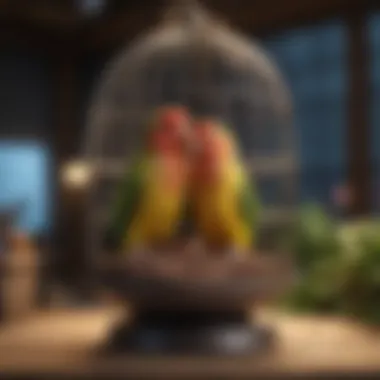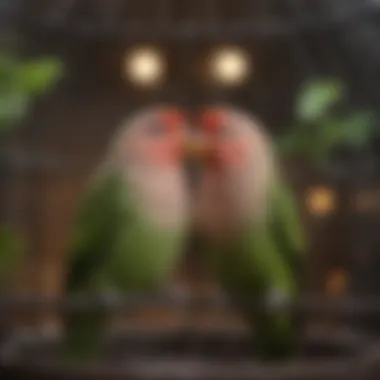Choosing the Best Cage for Your Lovebirds' Home


Intro
Selecting the appropriate cage for lovebirds is vital for any pet owner. Lovebirds are vibrant, social birds that require an environment that not only meets their physical needs but also enhances their emotional well-being. In this article, we will explore the significant factors to consider when choosing a cage for these charming pets, including size, material, and design preferences. The goal is to create a living space that supports their happiness and health. We will also touch on the essentials of care and maintenance that can further contribute to an optimal habitat for your feathered friends.
Understanding Your Pet
Pet Behavior Basics
Lovebirds are known for their playful and affectionate nature. They thrive on social interactions, both with humans and other birds. Understanding their behavior is crucial in selecting a cage that suits their needs. They often enjoy climbing, playing, and engaging in activities that challenge their intelligence. A cage that offers ample space for movement will allow lovebirds to exhibit their natural behaviors.
Common Breed Characteristics
There are several species of lovebirds, each with unique traits. The most common types include the Peach-faced, Fischer's, and Masked lovebirds. Peach-faced lovebirds, for example, are renowned for their sociable disposition, while Fischer's lovebirds can display more territorial behaviors. Familiarizing yourself with these characteristics aids in determining the cage size and setup that will accommodate your lovebird's specific tendencies.
Species-Specific Needs
Lovebirds have particular requirements that differ from other birds. They require a minimum cage size of 30 inches wide, 18 inches deep, and 36 inches tall. Smaller cages can lead to stress and health issues. Moreover, since they are social creatures, lovebirds do best in pairs or small groups. If planning to house more than one, ensure the cage is sufficiently spacious to prevent conflicts and allow for their natural socialization.
Pet Care and Maintenance
Feeding Guidelines
A balanced diet is essential for lovebirds. They primarily eat seeds, but fresh fruits and vegetables should also feature in their diet. A high-quality pellet designed for parakeets is beneficial. Make sure to change food and water daily to promote health.
Grooming Essentials
Regular grooming helps maintain your lovebird's feathers in good condition. This includes providing opportunities for bathing. A shallow dish of water or a gentle misting can encourage bathing behavior, helping to keep their feathers clean and healthy.
Hygiene Practices
Keeping the cage clean is crucial. Remove droppings daily and change the bedding weekly. Regular cleaning of perches, toys, and food dishes prevents bacteria buildup and ensures a safe environment for your feathered companions.
Training and Development
Basic Commands and Skills
Training lovebirds starts with basic commands such as
Understanding Lovebirds
Understanding lovebirds is an essential element in choosing the best cage for these captivating birds. This section delves into the specifics of lovebird species and their behavior, which directly influences the requirements for their living environment. Knowing these aspects can lead to more informed decisions when selecting a cage, ultimately fostering a happier and healthier habitat for your lovebirds.
An Overview of Lovebird Species
Lovebirds belong to the genus Agapornis, with several species recognized worldwide. The most common varieties among pet owners are the Peach-faced Lovebird, Fischer's Lovebird, and the Masked Lovebird. Each species exhibits unique colors and temperaments, making them suitable for different households.
- The Peach-faced Lovebird
- Fischer's Lovebird
- Masked Lovebird
These species vary not only in appearance but also in social behaviors. For example, Fischer's Lovebirds are known for their playful nature. Understanding these differences helps in selecting a cage that matches their specific needs.
Natural Habitat and Behavior
In the wild, lovebirds primarily inhabit regions in Africa, often found in areas of open savanna and forest edges. Thus, they are naturally inclined to enjoy wide spaces where they can fly and explore. Their strong social bonds also mean that lovebirds thrive in pairs or small groups, emphasizing the necessity for a spacious cage that accommodates more than one bird.
Lovebirds are active and curious creatures. They require stimulation through climbing and flying. Ideally, their cage should reflect their natural habitat, providing ample space to move around freely.


- Natural flying height is crucial for lovebirds.
- They need toys and perches to mimic climbing in trees.
- Social interaction is significant for their well-being.
Creating a habitat that considers these aspects leads to a more enriched and fulfilling environment for lovebirds. Therefore, understanding their species and natural behaviors greatly enhances the selection process for their cage.
Cage Size Considerations
Cage size is a critical aspect of ensuring your lovebirds thrive in captivity. It impacts their physical health and emotional well-being. An appropriately sized cage allows for adequate movement and plays a key role in reducing stress. Over time, stress can lead to health issues in lovebirds, such as feather plucking or other behavioral problems. Therefore, understanding cage size considerations helps you create an environment that caters to their natural instincts and needs.
Space Requirements for Lovebirds
Lovebirds are active and playful creatures. They require ample space to fly, climb, and engage in natural behaviors. Generally, it’s advisable to keep lovebirds in pairs or small groups, as they are social animals. Thus, the cage must accommodate their social dynamics, ensuring that each bird has enough room to interact without feeling cramped.
The minimum space requirement should not be underestimated. Lovebirds benefit from having areas where they can exercise and explore. You might consider a cage that allows them to stretch their wings fully and move around comfortably. A spacious cage can also support various toys and accessories, contributing to an enriched environment.
Minimum Cage Dimensions
When selecting a cage for your lovebirds, you might come across various recommendations regarding minimum cage dimensions. For a pair of lovebirds, a recommended size is at least 24 inches long, 18 inches wide, and 24 inches high. This provides a comfortable space for flying and other activities.
However, larger dimensions are preferable. A cage that is 36 inches long, 24 inches wide, and 36 inches high will allow for greater mobility and more functional space for perches and toys. Remember, the more space you provide, the happier and healthier your lovebirds will be. Be sure to measure the space where the cage will reside to ensure a good fit in your home.
Vertical vs.
Horizontal Space
Understanding the difference between vertical and horizontal space is crucial when choosing a cage for lovebirds. Lovebirds tend to fly upward more often than horizontally. Thus, a taller cage can be more beneficial than a wider one. A vertical design allows them to employ their natural climbing and flying behaviors, promoting physical health.
However, horizontal space is also important. A cage that is too narrow may restrict their movement and limit their ability to engage in social behaviors. Ideally, you should look for a cage that strikes a balance between both vertical and horizontal space. Keep in mind that perches should be arranged at different heights to encourage climbing and exploration in the cage.
Cage Materials
Selecting the right cage materials is crucial when it comes to ensuring the health and safety of your lovebirds. The materials used not only affect the structural integrity of the cage but also influence the well-being of your feathered friends. A lovebird's cage needs to be strong enough to withstand their playful nature, yet safe and non-toxic to prevent any health issues. Proper cage materials contribute substantially to a lovebird's life satisfaction.
Types of Cage Materials
When it comes to lovebird cages, several different materials are commonly used:
- Metal: Typically made from stainless steel or powder-coated steel, metal cages are durable and easy to clean. However, one should ensure the finish is safe and free from harmful coatings.
- Plastic: While lighter and cheaper, plastic cages may not provide the needed strength for active lovebirds. They can also be challenging to clean and may harbor bacteria if not maintained properly.
- Glass: Glass cages offer visibility and aesthetics but can be heavy and less ventilated. Proper airflow is essential for lovebirds, so this can be a drawback.
- Wood: Wooden cages can be visually appealing but must be treated carefully. Some finishes may contain harmful chemicals. Furthermore, wood can be hard to clean and may retain odors.
When choosing a cage, consider materials that offer a balance of safety, durability, and ease of maintenance suitable for lovebirds.
Safety and Durability Factors
Safety is of utmost concern when selecting cage materials. Here are key factors to consider:
- Non-toxic finishes: Ensure the cage material is coated with paint or finishes that are safe for birds. Toxic materials can lead to serious health issues.
- Rust-resistant: Cage materials should withstand moisture without rusting. Stainless steel is an excellent choice due to its resistance.
- Durable construction: An adequately constructed cage can endure the daily activities of lovebirds, reducing the risk of injury. Look for strong welds and robust design.
- Easy-to-clean surfaces: Cages should be easy to clean to maintain hygiene. Bacteria can thrive in dirty environments.
A high-quality cage keeps lovebirds safe while enhancing their living conditions, leading to happier and healthier pets.
In summary, the choice of materials used in a lovebird’s cage impacts a range of factors from safety to cleaning convenience. Understanding the different types and ensuring safety features is key to making an informed decision.
Cage Design Features
When choosing a cage for your lovebirds, the design features are crucial. They directly impact the comfort and safety of your birds. A well-thought-out design not only ensures that lovebirds are secure but also promotes their well-being and happiness. Considerations such as bar spacing, overall layout, and additional accessories can enhance the living environment significantly.
Bar Spacing and Structure


The spacing between the bars of the cage is vital for the safety of lovebirds. If the bars are too far apart, there is a risk that the birds can escape or get stuck. A typical recommendation for lovebirds is to have bar spacing of about ½ inch to ¾ inch. This range is ideal. Furthermore, the structure of the bars matters. Vertical bars are generally preferred because they give lovebirds more grip and make climbing easier. Metal cages are generally more durable than plastic, offering better safety and stability.
Proper bar spacing and structure is key to preventing injuries and escapes.
Accessibility and Layout
An accessible cage encourages interaction and socialization. Ensure that the door openings are large enough for easy access for cleaning and feeding. The layout inside the cage is just as important. Lovebirds require areas where they can perch, play, and hide. A multi-level layout is beneficial. This enables birds to exercise and explore, mimicking their natural behaviors. Also, placing feeding bowls at various levels encourages movement.
Additional Accessories and Perches
To enhance the cage environment, consider adding accessories. Natural wood perches of various sizes inviteal lovebirds to exercise their feet and prevent boredom. It's also wise to include toys that are safe and non-toxic. These can be hanging, such as ropes and chewable materials, or stationary things that encourage digging and exploration. These items add to the bird's quality of life by catering to their instinctual behaviors and promoting both physical and mental stimulation.
In summary, the design features of a cage should not be overlooked. Selecting the right cage involves thoughtful consideration of bar spacing, ease of accessibility, and suitable accessories. These elements collectively ensure a healthy and engaging environment for lovebirds, allowing them to thrive as cherished residents of your home.
Placement of the Cage
Choosing the right placement for a lovebird cage is crucial for their overall wellbeing. Where the cage sits can greatly influence the birds' health, behavior, and stress levels. It is not just about finding a corner; it’s about creating an environment that supports their needs and allows them to thrive. The ideal location can protect the birds from extreme conditions while enabling social interactions with their owners.
Ideal Locations within the Home
The best locations for lovebird cages are areas that are both safe and stimulating. Considering their natural behaviors, placing the cage in a living area is recommended. This allows lovebirds to observe family activities, reducing feelings of isolation.
Here are some factors to think about:
- Natural Light: Lovebirds enjoy bright environments but avoid direct sunlight during peak hours. A well-lit room can help maintain an active lifestyle.
- Quiet Corners: While they like social interactions, areas with too much noise can create stress. Find a balance between being in the action and having a peaceful zone.
- Avoiding Kitchen Spaces: Kitchens may pose risks from fumes and fluctuating temperatures. Likewise, avoid placing the cage near windows where drafts can affect the birds.
Environmental Factors to Consider
Several environmental factors affect how suited a location is for lovebirds. Before deciding on a cage placement, consider:
- Temperature Stability: Lovebirds can be sensitive to temperature changes. Ensure the cage is in a location with stable temperatures away from heaters or air conditioning units.
- Humidity Levels: Excessive humidity can lead to health issues. A dry environment is preferable, but too dry can also be harmful. Monitor the humidity in the room where the cage is located.
- Predator Presence: Keep the cage away from potential threats, such as household pets or even larger birds outside. A secure area will lessen stress for lovebirds.
It is essential to strike a balance between visibility and comfort for your lovebirds, as the right placement supports their physical and psychological needs.
Maintenance and Cleaning
Maintaining a clean and hygienic environment for your lovebirds is essential for their health and wellbeing. Proper maintenance of their cage is not merely a chore; it significantly impacts the birds’ physical health as well as their psychological comfort. Healthy lovebirds are active and sociable, which can be compromised by unsanitary living conditions. Therefore, implementing an effective cleaning regimen alongside selecting the right materials is crucial for creating a safe habitat.
Cleaning Regimen for Lovebird Cages
A consistent cleaning regimen helps prevent disease and keeps your lovebirds comfortable. Here are essential steps to consider:
- Daily Cleaning: Remove leftover food, droppings, and any soiled bedding. This minimizes bacteria and odor.
- Weekly Deep Cleaning: Wash the cage with a bird-safe disinfectant. Pay attention to corners and any hidden spots. It is also important to clean accessories like perches, toys, and food containers.
- Monthly Overhaul: Replace any worn or damaged items. Inspect the entire cage for any needed repairs. This is also an ideal time to observe your birds’ patterns for any signs of stress or illness.
It is crucial to use cleaning products that are safe for birds. Many common household cleaners contain chemicals that can be harmful to these sensitive animals.
Materials That Simplify Cleaning
Choosing the right materials for the cage can vastly reduce the time and effort spent on cleaning. Consider the following options:
- Stainless Steel: This material is non-porous and can withstand rigorous cleaning, making it less likely to harbor bacteria.
- Plastic-Coated Wire: It is easier to clean than raw metal and often available in a variety of colors. Ensure the coating is non-toxic.
- Glass or Acrylic: These materials can provide a clear view of your birds while allowing easy scrubbing for upkeep.
Common Mistakes to Avoid
Choosing the right cage for lovebirds requires careful consideration. Despite the best intentions, pet owners can make errors that impact the wellbeing of these birds. Identifying and avoiding these common mistakes is crucial for creating an optimal environment. This section aims to clarify the most frequent pitfalls, providing insights that will enhance your selection process. Being aware of these mistakes will lead to better decisions and ultimately contribute to a healthier, happier life for your lovebirds.


Underestimating Space Needs
A significant mistake many lovebird owners make is underestimating the space requirements. Lovebirds are active and social creatures. They need room to fly, explore, and interact with their environment. A cage that is too small can lead to stress and behavioral issues. To ensure sufficient space:
- Consider the number of birds: More lovebirds require more space.
- Evaluate activity levels: Lovebirds are naturally curious and energetic.
- Measure the cage dimensions: Verify that the width, depth, and height accommodate play and movement.
Larger cages not only promote physical health but also support emotional wellbeing. When lovebirds have ample space, they are less likely to develop anxiety or engage in destructive habits. An ideal cage should have dimensions that allow for comfortable movement, enabling flying, perching, and nesting.
Choosing Inappropriate Materials
Selecting the right materials for a lovebird cage is essential, yet many owners overlook this aspect. Poor material choices can lead to safety hazards and affect the cage’s longevity. Common mistakes include:
- Opting for galvanized metal: This may contain zinc, which is toxic to birds.
- Using cheap plastics: Some plastic materials can be harmful if chewed on.
- Ignoring rust resistance: A cage that rusts can pose health risks.
It is advisable to choose cages made of stainless steel or powder-coated metal. These materials are safe and durable. Additionally, ensuring the cage is easy to clean will help maintain a healthy environment for the birds.
Ignoring Social Needs of Lovebirds
Lovebirds are inherently social animals. One common error is failing to acknowledge their social needs, which can dramatically influence their behavior and mood. A few considerations include:
- Providing companionship: Keeping a single lovebird can lead to loneliness. It may be beneficial to have at least two together.
- Social interaction with humans: Daily interaction is important for their development and happiness.
- Enriching the environment: Toys and activities stimulate mental engagement.
Ignoring these needs can lead to loneliness, stress, and even depression in lovebirds. Ensuring that their social requirements are met is vital for their overall wellbeing and quality of life. Providing a nurturing and stimulating environment fosters healthy social behavior.
In summary, being aware of common mistakes in cage selection empowers owners to create a suitable habitat for lovebirds. Paying attention to space requirements, choosing appropriate materials, and addressing social needs will lead to healthier and happier birds.
Recommendations for Quality Lovebird Cages
Choosing the right cage for lovebirds is crucial for their happiness and health. This section highlights the significance of quality cages tailored to their specific needs. Selecting a cage that meets optimal size, safety, and design standards is not only beneficial but essential for the well-being of these social birds. This ensures they have a safe space to thrive, minimizing stress and promoting an active lifestyle.
Top Brands and Models
When looking for the perfect cage, it is important to consider reputable brands known for their quality and safety. This ensures you get durable and well-designed products. Here are some notable brands and models:
- A&E Cage Company: Known for its robust materials and thoughtful designs. A&E offers a variety of cage sizes perfect for lovebirds.
- Vision Bird Cages: These cages come with a unique design that allows for better visibility and accessibility. They prioritize both aesthetics and functionality.
- Zupreem Cages: Renowned for integrating safety features, Zupreem focuses on creating cages that facilitate an enriching environment for birds.
- Prevue Hendryx: This brand offers a range of cages specifically designed for smaller birds like lovebirds, and they come with multiple accessories.
These brands represent reliability and quality. Always check the specific features of each model to ensure they meet your lovebird's needs.
Buyer Reviews and Insights
Buyer reviews are a valuable resource when selecting a cage. They provide unique insights into the actual experiences of pet owners. Here are common observations from buyer feedback:
- Durability: Many users emphasize the importance of a cage that withstands wear and tear. Reviews frequently highlight how certain materials hold up over time.
- Ease of Cleaning: Owners appreciate cages that simplify cleaning processes. Cages with removable trays and non-toxic materials rate highly among buyers.
- Breathability and Space: Lovebirds require ventilation and space to move around. Positive reviews often mention cages that provide ample space and adequate air flow.
- Accessories Included: Consumers enjoy cages that come with necessary accessories, such as perches and feeding bowls. This aspect often influences purchasing decisions.
Overall, understanding buyer insights can greatly assist in making a well-informed choice. This not only helps in selecting a suitable cage but also enhances the overall lovebird care experience.
The End
Selecting the right cage for lovebirds is a crucial aspect of their care. The choices made during this process can significantly impact their health, wellbeing, and happiness. A proper cage goes beyond simple aesthetics; it serves as the primary environment in which lovebirds will live, play, and socialize. Proper consideration of size, materials, and design features ensures that their needs are met.
Summarizing Essential Points
In this article, we have discussed several key factors when choosing a cage for lovebirds. Here are the essential points:
- Cage Size: Lovebirds require ample space to move and explore. The cage should not only accommodate their physical needs but also allow them to engage in natural behaviors such as flying and climbing.
- Materials: The material of the cage must ensure safety and durability. Avoid cages that are painted with hazardous materials and options that might rust or break easily.
- Design Features: Factors like bar spacing, overall structure, and accessibility are critical. These elements must ensure that the birds can safely perch and interact without risk of injury.
- Placement: The location of the cage within the home can alter the lovebirds’ experience. Ideally, it should be placed in a lively area where they receive social interaction.
Final Thoughts on Lovebird Care
As you consider the best cage for your lovebirds, remember that their happiness and health depend largely on the environment you create. Lovebirds thrive in social settings, and the right cage enhances their overall quality of life. By paying attention to specifics such as size, material, and design, you can foster an enriching habitat that meets their natural needs.
"A well-chosen cage can lead to a happier and healthier lovebird."
Ensuring your feathered companions have an optimal living space contributes profoundly to their emotional and physical wellbeing. This guide aims to empower pet owners with the knowledge to make informed choices that promote a fulfilling and joyful life for lovebirds.







